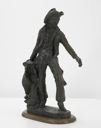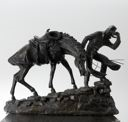Hughes William Curtis does not have an image.
Hughes William Curtis
(Springville, Utah, 1904 - 1972, Springville, Utah)
Hughes Curtis is one of few bronze sculptors who was primarily self-taught. His scenes of the West are inspired by his own real-life experiences. The result is art that is as individual and original as the person. Curtis was born in a two-room adobe house in Springville, Utah, in 1904, when the town was a railroad hub and still a stranger to electricity. To be a herder or a cowboy was, out of necessity, a common lifestyle. Growing up in this rugged environment, Curtis took on a tough exterior that shaped his personality and behavior. As a boy, he and his brothers were accustomed to "hitching a ride" on the slow trains that moved through Spanish Fork Canyon. One time Hughes slipped, and his leg became tangled under a wheel and had to be cut off at the knee. Although this accident made his childhood difficult because of a lack of acceptance by others, it also caused the young Curtis to explore his artistic abilities. Hughes' father, Val Curtis, often had to whittle new crutches for the boy. Unfortunately, Hughes was capable of breaking them as fast as his father could make them. Father Curtis finally threatened Hughes, saying he would have to make his own crutches if he broke this last pair, hoping it would subdue his activity. However, by the time he was nine years old, Hughes had learned to walk with only one crutch and was able to make his own. He used a hexagonal design made of solid oak and walnut. His pocket knife became his constant companion and was used to turn kindling into tiny wooden guns, animals, wagons, and whistles. Whenever Hughes was sitting, he was carving, modeling, or sketching. While other boys were playing baseball, he sat on the river bank molding the native clay. His school notebooks and texts were full of caricatures, and he carved a platoon of toy soldiers out of the school's chalk. Hughes "admitted that had he not lost his leg, he never would have done anything about his urge to create." Hughes Curtis was about 15 years old when he met Cyrus Dallin. Curtis had only recently been given his first commission to carve the panels of a horse-drawn hearse when the famous sculptor returned to Springville for the summer. Dallin taught Curtis how to practice carving on a yielding block of plaster, and when he realized the serious attitude of the young artist, Dallin gave him many suggestions on how to improve. Before long, Hughes began modeling clay. Dallin showed him how to support his figures internally with armatures. When Hughes understood the personality of clay, how to keep it from drying, how to keep it from getting too moist, and the ease and pliability of the native clay, he immediately abandoned his first love of wood carving. Over time and with more help from Dallin, Hughes learned the piece-mold method of sculpture and enjoyed the new freedoms clay allowed. However, Hughes hoped to be able to attend art school and travel to Paris like Dallin and Hafen had done. He devised a plan to work as a barber and earn money to pay for school. Unfortunately, the Depression deterred his plan and kept his dream out of sight. Hughes Curtis' good friend Howard Kearns had been able to afford art school. He sent his books home from the California Arts School for Hughes to borrow. Whenever Howard was home from school, the two friends were inseparable and often went on "art excursions." Howard painted or sketched and Hughes gained inspiration for his next sculpture through watching scenes of Indians and ranchers, western life. "Saddling Up" (1942), is an example of the candid scenes they encountered. Curtis wished his clay models could take on a more permanent form and began to build his own bronze foundry. After a lot of hard work, Curtis succeeded in building Utah County's first foundry. Until Brigham Young University built its own foundry, the University depended very heavily on the kindness of Hughes Curtis in letting students use his. Another sculptor in the county, Ed Fraughton, showed Curtis the benefits of a synthetic rubber mold for better reproductions. In a short time, Curtis had a first-rate working foundry for his own creations. In 1960, Hughes' mother died, and he began a relationship with a woman, Cecile, whom he married three years later. Over the next decade, Hughes Curtis produced several western bronzes from his experiences. Curtis died in 1972, leaving his wife Cecile to bear his only child a month and a half later. As an artist, Hughes Curtis remains best known for his contributions to the "bronco busting" genre of realistic western sculpture. Cecile continued to cast his bronzes for many years, keeping his memory alive.
(Springville, Utah, 1904 - 1972, Springville, Utah)
Hughes Curtis is one of few bronze sculptors who was primarily self-taught. His scenes of the West are inspired by his own real-life experiences. The result is art that is as individual and original as the person. Curtis was born in a two-room adobe house in Springville, Utah, in 1904, when the town was a railroad hub and still a stranger to electricity. To be a herder or a cowboy was, out of necessity, a common lifestyle. Growing up in this rugged environment, Curtis took on a tough exterior that shaped his personality and behavior. As a boy, he and his brothers were accustomed to "hitching a ride" on the slow trains that moved through Spanish Fork Canyon. One time Hughes slipped, and his leg became tangled under a wheel and had to be cut off at the knee. Although this accident made his childhood difficult because of a lack of acceptance by others, it also caused the young Curtis to explore his artistic abilities. Hughes' father, Val Curtis, often had to whittle new crutches for the boy. Unfortunately, Hughes was capable of breaking them as fast as his father could make them. Father Curtis finally threatened Hughes, saying he would have to make his own crutches if he broke this last pair, hoping it would subdue his activity. However, by the time he was nine years old, Hughes had learned to walk with only one crutch and was able to make his own. He used a hexagonal design made of solid oak and walnut. His pocket knife became his constant companion and was used to turn kindling into tiny wooden guns, animals, wagons, and whistles. Whenever Hughes was sitting, he was carving, modeling, or sketching. While other boys were playing baseball, he sat on the river bank molding the native clay. His school notebooks and texts were full of caricatures, and he carved a platoon of toy soldiers out of the school's chalk. Hughes "admitted that had he not lost his leg, he never would have done anything about his urge to create." Hughes Curtis was about 15 years old when he met Cyrus Dallin. Curtis had only recently been given his first commission to carve the panels of a horse-drawn hearse when the famous sculptor returned to Springville for the summer. Dallin taught Curtis how to practice carving on a yielding block of plaster, and when he realized the serious attitude of the young artist, Dallin gave him many suggestions on how to improve. Before long, Hughes began modeling clay. Dallin showed him how to support his figures internally with armatures. When Hughes understood the personality of clay, how to keep it from drying, how to keep it from getting too moist, and the ease and pliability of the native clay, he immediately abandoned his first love of wood carving. Over time and with more help from Dallin, Hughes learned the piece-mold method of sculpture and enjoyed the new freedoms clay allowed. However, Hughes hoped to be able to attend art school and travel to Paris like Dallin and Hafen had done. He devised a plan to work as a barber and earn money to pay for school. Unfortunately, the Depression deterred his plan and kept his dream out of sight. Hughes Curtis' good friend Howard Kearns had been able to afford art school. He sent his books home from the California Arts School for Hughes to borrow. Whenever Howard was home from school, the two friends were inseparable and often went on "art excursions." Howard painted or sketched and Hughes gained inspiration for his next sculpture through watching scenes of Indians and ranchers, western life. "Saddling Up" (1942), is an example of the candid scenes they encountered. Curtis wished his clay models could take on a more permanent form and began to build his own bronze foundry. After a lot of hard work, Curtis succeeded in building Utah County's first foundry. Until Brigham Young University built its own foundry, the University depended very heavily on the kindness of Hughes Curtis in letting students use his. Another sculptor in the county, Ed Fraughton, showed Curtis the benefits of a synthetic rubber mold for better reproductions. In a short time, Curtis had a first-rate working foundry for his own creations. In 1960, Hughes' mother died, and he began a relationship with a woman, Cecile, whom he married three years later. Over the next decade, Hughes Curtis produced several western bronzes from his experiences. Curtis died in 1972, leaving his wife Cecile to bear his only child a month and a half later. As an artist, Hughes Curtis remains best known for his contributions to the "bronco busting" genre of realistic western sculpture. Cecile continued to cast his bronzes for many years, keeping his memory alive.



